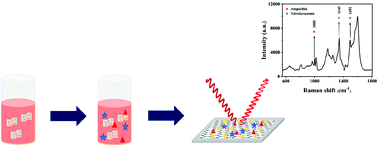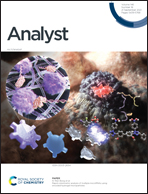A highly reproducible SERS sensor based on an Au nanoparticles/graphene oxide hybrid nanocomposite for label-free quantitative detection of antibiotics†
Abstract
Ampicillin and nitrofurantoin, as broad-spectrum antibiotics, are widely used in the prevention of animal diseases and to ensure livestock growth. Large amounts of antibiotic residues exist in animal-derived foods, affecting food quality and safety, causing adverse side effects, such as allergic and toxic reactions, and increasing bacterial resistance. A sensitive surface enhanced Raman scattering (SERS) sensor is provided to detect low-concentration antibiotics (ampicillin and nitrofurantoin). The sensor is based on an Au nanoparticles/graphene oxide hybrid nanocomposite prepared by an in situ reduction method. The detection limits of ampicillin and nitrofurantoin are as low as 0.01 ng mL−1 and 5 ng mL−1, respectively. The relative spectral intensity of the nitrofurantoin characteristic peak has a good linear relationship with the concentration of nitrofurantoin in the range of 500 ng mL−1 and 5 ng mL−1 (R2 = 0.99235). The structure also allows multi-sample measurement for a variety of antibiotics at the same time. The SERS sensor is easy to prepare, with high uniformity and reproducibility, and the sample does not require complex pretreatment and preparation. Sensitive and quantitative detection of antibiotics by the SERS sensor is of great interest in the fields of health care, food preparation, and environmental sampling.



 Please wait while we load your content...
Please wait while we load your content...